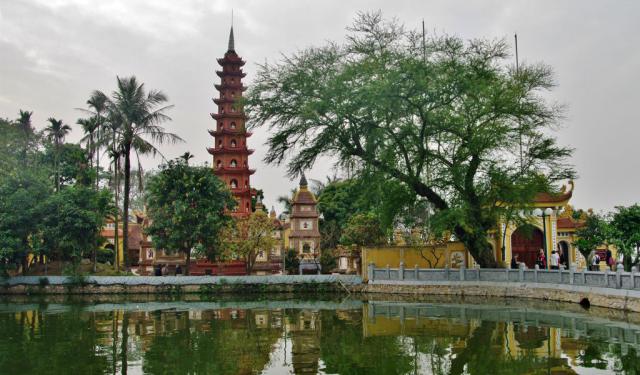Bach Ma Temple, Hanoi
Bach Ma Temple, also known as the Temple of the White Horse, is one of the oldest and most significant places of worship in Hanoi. Built in 1010, the temple is dedicated to Long Do, the patron saint of Hanoi, whose name translates to "Dragon’s Belly."
The temple's origin is intertwined with the history of Hanoi itself. When King Lý Thái Tổ transferred the capital from Hoa Lư to Thăng Long (the ancient name of Hanoi), he was guided by a white horse that appeared and led him to the temple's current location. This event was considered an auspicious sign, and the king began constructing the city's walls from this site. Although only a few parts of the original structure remain, the temple as it stands today is primarily a result of 18th-century reconstruction efforts.
Bach Ma Temple is situated in the heart of Hanoi's Old Quarter, a vibrant area that reflects the city's rich history and culture. The temple complex consists of six main sections: the altar, the square house, the great house of ceremony, the incense chamber, the sanctuary, and the meeting hall. Each section has its unique function and significance, contributing to the temple's role as a center of worship and community gathering.
The temple houses numerous relics, including stone steles that document its history, royal ordinances, and records of restorations from the Lê to the Nguyễn dynasties. In 1839, a shrine to Confucius was added, highlighting the temple's importance in both religious and educational contexts.
Visitors to Bach Ma Temple can pass through its old wooden doors and explore its historical and cultural artifacts. Noteworthy treasures include a statue of the white horse that led King Lý Thái Tổ to the temple site and a red lacquer funeral palanquin. These artifacts, along with the temple's architecture and historical records, provide a glimpse into the rich heritage of Hanoi and the enduring legacy of Bach Ma Temple.
The temple's origin is intertwined with the history of Hanoi itself. When King Lý Thái Tổ transferred the capital from Hoa Lư to Thăng Long (the ancient name of Hanoi), he was guided by a white horse that appeared and led him to the temple's current location. This event was considered an auspicious sign, and the king began constructing the city's walls from this site. Although only a few parts of the original structure remain, the temple as it stands today is primarily a result of 18th-century reconstruction efforts.
Bach Ma Temple is situated in the heart of Hanoi's Old Quarter, a vibrant area that reflects the city's rich history and culture. The temple complex consists of six main sections: the altar, the square house, the great house of ceremony, the incense chamber, the sanctuary, and the meeting hall. Each section has its unique function and significance, contributing to the temple's role as a center of worship and community gathering.
The temple houses numerous relics, including stone steles that document its history, royal ordinances, and records of restorations from the Lê to the Nguyễn dynasties. In 1839, a shrine to Confucius was added, highlighting the temple's importance in both religious and educational contexts.
Visitors to Bach Ma Temple can pass through its old wooden doors and explore its historical and cultural artifacts. Noteworthy treasures include a statue of the white horse that led King Lý Thái Tổ to the temple site and a red lacquer funeral palanquin. These artifacts, along with the temple's architecture and historical records, provide a glimpse into the rich heritage of Hanoi and the enduring legacy of Bach Ma Temple.
Want to visit this sight? Check out these Self-Guided Walking Tours in Hanoi. Alternatively, you can download the mobile app "GPSmyCity: Walks in 1K+ Cities" from Apple App Store or Google Play Store. The app turns your mobile device to a personal tour guide and it works offline, so no data plan is needed when traveling abroad.
Bach Ma Temple on Map
Sight Name: Bach Ma Temple
Sight Location: Hanoi, Vietnam (See walking tours in Hanoi)
Sight Type: Religious
Sight Location: Hanoi, Vietnam (See walking tours in Hanoi)
Sight Type: Religious
Walking Tours in Hanoi, Vietnam
Create Your Own Walk in Hanoi
Creating your own self-guided walk in Hanoi is easy and fun. Choose the city attractions that you want to see and a walk route map will be created just for you. You can even set your hotel as the start point of the walk.
Hanoi's Old Quarter Walking Tour
The Old Quarter (Vietnamese: Phố cổ Hà Nội) is the name commonly given to the historical civic urban core of the city, located outside the Imperial Citadel of Thăng Long in the northern half of Hoàn Kiếm District, renowned for its small street blocks and alleys, and a traditional Vietnamese atmosphere.
During the Lê dynasty (1428-1789), the area included several lakes and wetlands... view more
Tour Duration: 2 Hour(s)
Travel Distance: 4.0 Km or 2.5 Miles
During the Lê dynasty (1428-1789), the area included several lakes and wetlands... view more
Tour Duration: 2 Hour(s)
Travel Distance: 4.0 Km or 2.5 Miles
Hanoi Introduction Walking Tour
Known for its centuries-old architecture and rich culture with Southeast Asian, Chinese and French influences, the capital of Vietnam, Hanoi, traces its origin back to the third century BC. Originally, a portion of modern-day Hanoi served as the capital of the historic Vietnamese nation Âu Lạc. Following the collapse of Âu Lạc, the city was made part of Han China (111 BC-40 AD).
... view more
Tour Duration: 2 Hour(s)
Travel Distance: 4.0 Km or 2.5 Miles
... view more
Tour Duration: 2 Hour(s)
Travel Distance: 4.0 Km or 2.5 Miles





